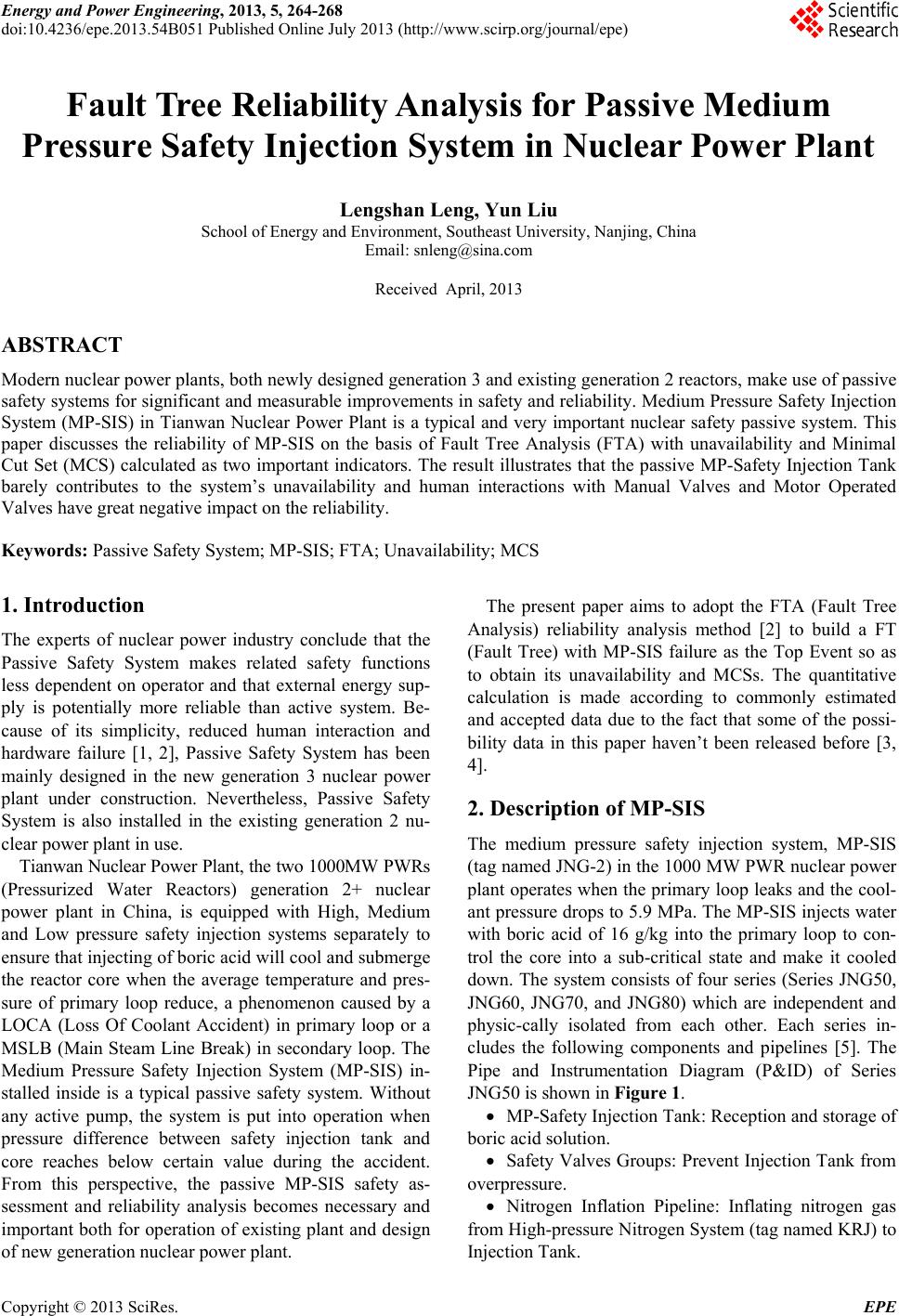
Energy and Power Engineering, 2013, 5, 264-268
doi:10.4236/epe.2013.54B051 Published Online July 2013 (http://www.scirp.org/journal/epe)
Fault Tree Reliability Analysis for Passive Medium
Pressure Safety Injection System in Nuclear Power Plant
Lengshan Leng, Yun Liu
School of Energy and Environment, Southeast University, Nanjing, China
Email: snleng@sina.com
Received April, 2013
ABSTRACT
Modern nuclear power plants, both newly designed generation 3 and existing generation 2 reactors, make use of passive
safety systems for significant and measurable improvements in safety and reliability. Medium Pressure Safety Injection
System (MP-SIS) in Tianwan Nuclear Power Plant is a typical and very important nuclear safety passive system. This
paper discusses the reliability of MP-SIS on the basis of Fault Tree Analysis (FTA) with unavailability and Minimal
Cut Set (MCS) calculated as two important indicators. The result illustrates that the passive MP-Safety Injection Tank
barely contributes to the system’s unavailability and human interactions with Manual Valves and Motor Operated
Valves have great negative impact on the reliability.
Keywords: Passive Safety System; MP-SIS; FTA; Unavailability; MCS
1. Introduction
The experts of nuclear power industry conclude that the
Passive Safety System makes related safety functions
less dependent on operator and that external energy sup-
ply is potentially more reliable than active system. Be-
cause of its simplicity, reduced human interaction and
hardware failure [1, 2], Passive Safety System has been
mainly designed in the new generation 3 nuclear power
plant under construction. Nevertheless, Passive Safety
System is also installed in the existing generation 2 nu-
clear power plant in use.
Tianwan Nuclear Power Plant, the two 1000MW PWRs
(Pressurized Water Reactors) generation 2+ nuclear
power plant in China, is equipped with High, Medium
and Low pressure safety injection systems separately to
ensure that injecting of boric acid will co ol an d sub merge
the reactor core when the average temperature and pres-
sure of primary loop reduce, a phenomenon caused by a
LOCA (Loss Of Coolant Accident) in primary loop or a
MSLB (Main Steam Line Break) in secondary loop. The
Medium Pressure Safety Injection System (MP-SIS) in-
stalled inside is a typical passive safety system. Without
any active pump, the system is put into operation when
pressure difference between safety injection tank and
core reaches below certain value during the accident.
From this perspective, the passive MP-SIS safety as-
sessment and reliability analysis becomes necessary and
important both for operation of existing plant and design
of new gen era tion nucl e ar power pla nt .
The present paper aims to adopt the FTA (Fault Tree
Analysis) reliability analysis method [2] to build a FT
(Fault Tree) with MP-SIS failure as the Top Event so as
to obtain its unavailability and MCSs. The quantitative
calculation is made according to commonly estimated
and accepted data due to the fact that some of the possi-
bility data in this paper haven’t been released before [3,
4].
2. Description of MP-SIS
The medium pressure safety injection system, MP-SIS
(tag named JNG-2) in the 1000 MW PWR nuclear power
plant operates when the primary loop leaks and the cool-
ant pressure drops to 5.9 MPa. The MP-SIS injects water
with boric acid of 16 g/kg into the primary loop to con-
trol the core into a sub-critical state and make it cooled
down. The system consists of four series (Series JNG50,
JNG60, JNG70, and JNG80) which are independent and
physic-cally isolated from each other. Each series in-
cludes the following components and pipelines [5]. The
Pipe and Instrumentation Diagram (P&ID) of Series
JNG50 is shown in Figure 1.
MP-Safety Injection Tank: Reception and storage of
boric acid solution.
Safety Valves Groups: Prevent Injection Tank from
overpressure.
Nitrogen Inflation Pipeline: Inflating nitrogen gas
from High-pressure Nitrogen System (tag named KRJ) to
Injection Tank.
Copyright © 2013 SciRes. EPE